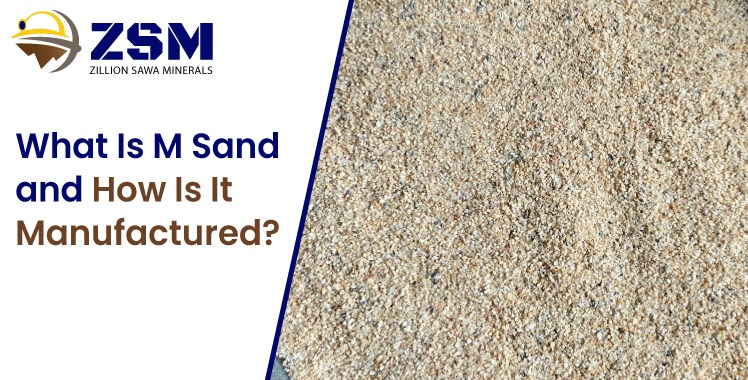
The production enterprise is developing rapidly, and so is the want for reliable, outstanding materials. Among them, M Sand has turn out to be a pinnacle desire because of its consistency, strength, and availability. Today, engineers and developers decide upon M Sand as a greater sustainable and green opportunity to river sand.
In this blog, we will discover what M Sand is, how the M Sand production manner works, and why Zillions Sawa Minerals is one of the maximum depended on suppliers.
Introduction
Natural river sand is turning into scarce because of environmental regulations and overuse. As a result, M Sand has emerged as a reliable and green replacement. Its managed production manner guarantees first-class and uniformity, making it perfect for present day production needs.
What Is M Sand?
- Full Form: synthetic sand.
- Definition: M Sand is a form of production high-quality mixture is produced via crushing of difficult stones, basalt and granite being the maximum common.
- Key features:
o Angular and cubical particles.
o Controlled gradation.
o No impurities.
Why M Sand Is Beocming Popular?
- Shortage of River Sand – Mining of river sand has increased environmental concerns and availability of this sand.
- Quality Concerns of Natural Sand – River sand has clay and silt, and organic material which can compromise construction quality
- Government Regulations – New policies now constrain river sand mining, supply and demand for substitutes is increased.
- Sustainability Benefits – M Sand is produced using processes and methods for construction which reduces environmental impacts.
How M Sand is Manufactured
Getting M Sand involves precise techno-economic processes for M Sand to be of the same quality and standard as produced by any controlled plants.
- Choice of Raw Material
For its strength and durability, good quality granite or basalt is chosen
- Primary and Secondary Crushing
• Primary Crushing: Jaw crusher reduce bigger rocks to smaller bits.
• Secondary Crushing: Cone crushers works to reduce the smaller rocks to finer particles.
- Screening and Washing
• Screening is for classification by sizes.
• Washing clay, silt, dust, and other impurities are removed.
- Final Shaping of the Sand by VSI
Vertical Shaft Impactors or VSI shapes the sands to be more cubically uniform which are better for quality concrete.
- Final Inspection
Different grades of sand are separated as Construction M Sand and Plastering M Sand.
- Quality Assurance
Every batch undergoes rigorous inspection for:
• Particle length distribution
• Silt content
• Moisture content
• Specific gravity
Classification of M Sand
- Concrete M SAND- Used for R.C.C. work - creation of foundations, slabs, beams, and columns.
- Plastering M Sand (P-Sand):A smooth grade that is finer sand. For interior and exterior wall plastering.
- Block/Brick M Sand: For block work, brick laying, and other masonry.
- Specialty M Sand: Customized grades for enterprise or large-scale infrastructure.
Benefits of M Sand
- Uniform quality
- Higher compressive strength
- Better workability
- Environmentally and economically beneficial
- Easily accessible
- Contains no clay, silt, or natural impurities
Comparison between M Sand and River Sand
While river sand is dredged from river beds, M Sand is produced and as more advanced than M Sand river sand is more reliable at an engineering level.
| Characteristics | M Sand | River Sand |
| Strength | High | Moderate |
| Impurities | Very Low | Often High |
| Availability | Consistent | Limited |
| Shape of particle | Angular and Cubical | Smooth and Rounded |
| Cost | Economical | Expensive |
| Environmental Impact | Low | High |
Applications of M Sand in Construction
- RCC and Structural Concrete: Perfect for construction of high strength concrete.
- Wall Plastering: Fine, uniform grading achieves a clean end this is unfastened from cracks.
- Masonry and Brickwork: Ensures sturdy adhesion and progressed workability withinside the tactics of bricklaying and block work.
- Flooring: Provides a solid and level foundation for flooring that is durable and resistant to cracks.
- Road Construction: Provides excellent strength and compaction for the construction of roads and pavements and for the sub-base layers.
- Infrastructure Development: Ensures the provision of concrete that is durable and long-lasting for expansive structures and for projects of high complexity and that are of high structural load.
Why Choose Zillions Sawa Minerals for M Sand?
Zillions Sawa Minerals distinguishes itself for excellence in the manufacturing of M Sand and for its reliability.
- Strong Commitment to Quality: Quality assurance is done for every batch. We make sure every standard is met and every guideline is followed.
- Advanced Manufacturing Facilities: State-of-the-art vsi equipment, automatic classifying devices, and high quartz electromatic copper machines provide perfect work.
- Availability of Multiple M Sand Grades: All needs of production are met. From Concrete M Sand to Differentiated M Sand, to P-Sand.
- Bulk Supply and Logistic Support: All phases of any project, deliveries are done on time.
Conclusion
M-Sand is revolutionizing the construction industry because of it's top quality, great availability, and sustainable production practices.Learning details about the production process of M-Sand explains well why it is superior to river sand.
For construction professionals needing reliable, consistent, and large volumes of supply, Zillions Sawa Minerals is and industry trusted partner.
High quality M Sand?
Contact Zillions Sawa Minerals and enjoy our best services!
